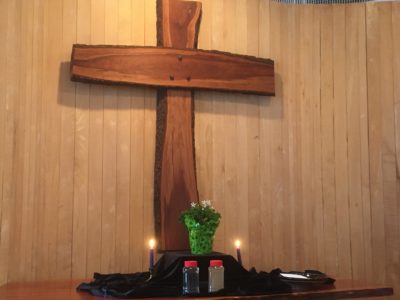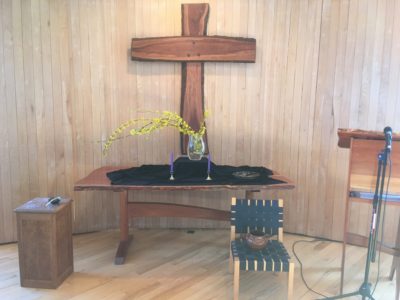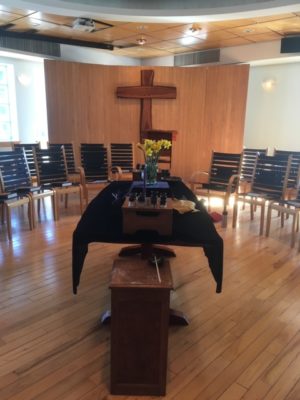Seekers recognizes that any member of the community may be called upon by God to give us the Word, and thus we have an open pulpit with a different preacher each week. Sermons preached at Seekers, as well as sermons preached by Seekers at other churches or events, are posted here, beginning with the most recent.
Click here for an archive of our sermons.
Feel free to use what is helpful from these sermons. We only ask that when substantial portions are abstracted or used in a written work, please credit Seekers Church and the author, and cite the URL.
“What’s in a Name” by Peter Bankson

March 29, 2020
The Fifth Sunday in Lent
Last Sunday, when we came together to worship online, I had a surprisingly wonderful sense of “being in this together.” There were about 50 of us, our variety captured in about 40 little thumbnails, each one unique, each one with a different name. Our names call forth our personalities. The image of Seekers Church gathered Last week on Zoom is hovering in my short-term memory as I think about finding a Word for this week.
We’re heading toward the end of our Lenten season, looking ahead, in just a few weeks, to Easter and the resurrection. Resurrection has been a sign of hope for a long, long time. But given the dire situation all around us, the dread and the unknown nurtured by the coronavirus pandemic, it seems clear to me that our vision of hope could use a reset.
Our worship theme for this season, “How can these things be?” invites me to consider this week’s lesson from the Hebrew Scripture. In Ezekiel 37:3 God asks Ezekiel, “Mortal, can these bones live?” And Ezekiel answered, “O Lord God, you know.” How can these things be?
Today we find ourselves in a global health crisis, in a situation where what we thought we knew isn’t ringing true. We need to see things from a different perspective. We need to call things as they are now and look for seeds of hope in unexpected places. Would a new name for our experience do any good? What’s in a name?
“Naming God – Lighting the Darkness” by Elese Sizemore

March 22, 2020
The Fourth Sunday in Lent
Today’s metaphor for God (Peter’s list): Precious Leaping Center of the Stuff of Life
Good morning everyone. This sermon is the last in a series of four presented by the Eyes To See, Ears To Hear Peace Prayer Mission Group on the topic of how we in this church each name and understand God. We have had several conversations about this subject in my group, including the issue of naming God in gendered and human terms, and how to best serve our diverse congregation, including our youth.
Today I would like to touch on the idea of how we “see” God and Christ, and how that informs how we see our faith.
I will start by asking you to close your eyes for a moment and try to conjure up a vision of what you SEE when you think of God.
“Bring Many Names” by Margreta Silverstone

March 15, 2020
The Third Sunday in Lent
Good morning. As you may recall, Eyes to See Ears to Hear Peace Prayer Mission Group has been in conversation with Celebration Circle for the past year about our naming of God within corporate worship. As part of that conversation, the mission group agreed to provide a series of sermons. This also follows on the Epiphany series of sermons that introduced you to the call and focus of the various mission groups within Seekers.
As a side note and given we are not meeting in person after this Sunday for a while, I encourage you to take the liturgy and the bulletin cover home. The inside has Peter’s many names for God. I used a random number generator to pick between 1 and 101 for each column and found different names. You will hear the results of this in what I share today.
We, as a faith community, benefit from the shared leadership that is embodied within mission groups. We benefit from Time & Space for the ongoing use and maintenance of this building. We benefit from Celebration Circle for their thoughtfulness in organizing our corporate worship. We benefit from Learners & Teachers for the weekly School for Christian Growth. And, we benefit from the Eyes to See, Ears to Hear peace prayer mission group with the Peace and Justice prayer that allows us to move from the gathering downstairs to the journey and gathering here. We, as a faith community, rely on this corporate body to strengthen and encourage our individual faith journeys. As we face into the new challenge of our community’s corporate health, we may need to learn new patterns of how to rely on each other in the days ahead.
“The Magnanimity of God” by Sandra Miller

March 8, 2020
The Second Sunday in Lent
Let us pray that the words of our mouths and the meditations of our hearts be of value to you, Holy One, ground of our being who opens the path to our personal and communal salvation. Amen
As you all know, I was unable to preach last Sunday. I would like to offer my public thanks to Pat for exchanging Sundays with me, and for how gracefully Celebration Circle shifted liturgists and roles to accommodate my illness. I had been entrusted by my mission group to offer an introduction to the cycle of 4 distinctly personal reflections by members of Eyes to See, Ears to Hear Peace Prayer Mission Group on the sensitive topic of how we name and understand God, and I would like to convey now some of what I prepared.
“Naming God” by Pat Conover

March 1, 2020
The First Sunday in Lent
Sandra was scheduled to preach this morning but is not well. I was scheduled to preach next Sunday and Sandra will take that slot. This sermon references the lectionary for next Sunday, particularly the famous John 3:16 scripture.
The first four sermons of March will be given by members of the Eyes to See mission group. The sermons grew out of our shared prayer time and conversations regarding the justice issues involved in naming God with masculine references. We had a mutually supportive conversation with Celebration Circle as part of our process. Our conversations deepened as we put our justice concerns in theological perspectives. We became aware that talking about God with gender references was part of the larger question of whether or not it is helpful to talk about God as if God is a human person.